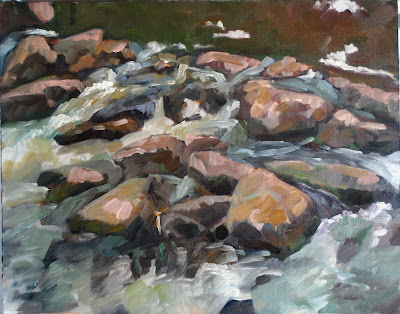When your car is too ratty for Buffalo, you may have a problem.
 |
| Erie Canal, by Carol L. Douglas |
I woke up to the smell of lake water in the air—a uniquely Buffalo smell, and one that presages rain. It’s my last day here, and I’ll be glad to head home after eight days on the road. I can’t keep up the pace of all this partying. It’s the official sport of Buffalo, after all.
Buffalo’s always been a hard-partying kind of town. At one time the bars stayed open all night to cater to shift-workers. There are no more manufacturing jobs, and the bars now close at 4 AM. I don’t know any American city more dedicated to drinking than that.
 |
| Rock tumble at the Holley canal spillway, by Carol L. Douglas |
My childhood chum Tim Wendel is in town promoting his newest book, Cancer Crossings. I’d like to catch up, but I comfort myself with the idea that he doesn’t have any more time than I do. I’d hoped to connect with another childhood friend, dancer Cynthia Cadwell Pegado. She’s one of my oldest friends, actually, since we met at our infant dedication at Delaware Baptist Church. I managed to connect with my sister-in-law and her new husband yesterday. And I had dinner in Ellicott Creek Park with my brother and his family. When your life is in your car, you meet up where you can.
It’s like this every time I go on a road trip, but never more so than when I’m in Buffalo. This is my home town, and I’m proud to be from here. However, I can’t see myself ever coming back to live. I can’t handle the pace.
 |
| Bluebells on the Erie Canal towpath. WNY has its moments of fascination, for sure. |
Buffalonians are, in general, polite drivers, but I still don’t much enjoy sitting in traffic. There’s more and more of that in my old haunts. After a sixty-year hiatus, my home town is finally coming into its own. I’ve waited for this, but I can’t say that I like it much.
I followed a Lamborghini down Niagara Falls Boulevard yesterday. This was always a city of rusty cargo vans. Suddenly, I’m self-conscious about the condition of the old Mercury Monterey we’re tooling around in. I didn’t realize it was possible to drive a car that’s too ratty for Buffalo.
I drove to Grand Island to look at a replacement for my trusty Prius yesterday. At 257,000 miles, it’s grown fragile. My best option, I think, is a pickup truck. “That’s a rather extreme shift,” my daughter commented.
 |
| After 257,000 miles and 13 years, the Prius is growing fragile. |
I’m spending more and more time on back roads. My Prius, while indomitable, has broken two springs. It was never designed for the dirt roads of Nova Scotia, for example. It’s too small to camp in, and I had to have the roof repainted after (inadvisably) carrying my canoe on it.
I looked at SUVs, but they all seem designed more for luxury than for off-roading. I hate scrubbing paint out of upholstery, so a truck is starting to look like my best choice. Still, $40,000 is a lot to spend on a vehicle.
 |
| I don’t even remember painting this sketch of a NYSDOT tug on the Erie Canal. I wonder where it ended up. |
I have one more task—to load my youngest kid’s stuff in my van—and then we can take off. By mid-afternoon, I should be tooling east on US 90 toward Massachusetts. After that, I get to work in earnest. I have a commission to finish, and a piece to write for Saranac Lake, and if I plan to make any money this summer, I’d better deliver some new work to my galleries.






